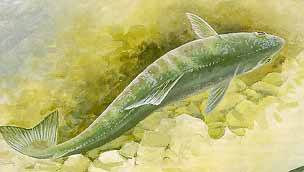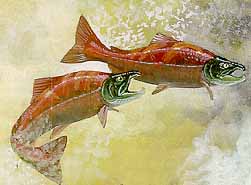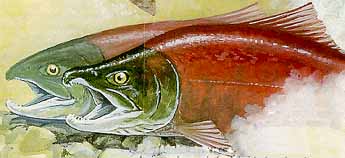 |
 |
Bibliography | Home |
![]()
From the U.S.
Fish and Wildlife Service brochure: Salmon of the Pacific Coast
Illustrations © 1994 by Shari Erickson
 |
When a female salmon arrives at her home stream, she chooses a nesting site with just the right combination of clean gravel, adequate depth, and good flow to provide oxygen for her eggs. She digs her nest by rolling onto her side and pumping her tail against the gravel. Stones are dislodged and carried downstream by the current. Every so often, she checks the depth of the nest by "crouching": lowering herself into the nest and inserting her anal fin into the spaces between the stones. |
| Males fight for access to nest-building females. The dominant male courts the female by quivering and crossing over her back. |  |
 |
When she is ready to lay, he moves alongside her and together they release eggs and milt. At the last moment subordinate males rush in and may manage to fertilize some of the eggs. The eggs settle into the spaces between the stones. The nest is covered with loose gravel as the female builds another nest upstream. Both male and female soon die after spawning, but females will defend the nest until they are too weak to do so. |
Challenges:
Spawning
|
|
![]()
| Salmon and Steelhead Life Cycle: | Early Stages | Adult | Spawning |
| Salmon and Steelhead Habitats: | Freshwater | Ocean |
![]()
| www.krisweb.com |